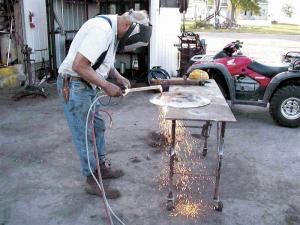2003 - Volume #27, Issue #5, Page #17
[ Sample Stories From This Issue | List of All Stories In This Issue | Print this story
| Read this issue]
FARM SHOW Tests New Gas Torch
 |
The gas torch has actually been used for nearly a decade in China, where it was developed. The inventor is a Chinese university engineer and researcher. He's successfully patented it in much of the world, including the U.S. It's called "oPetrol." I emailed the company to see if there was a dealer in the U.S. yet. The answer was no, but they offered to send a unit for FARM SHOW to test, provided we paid the shipping. We decided to take them up on their offer and they shipped it out of Hong Kong on a Monday by airfreight. The delivery truck dropped it off at my home in Iowa the following Friday morning.
The system consists of a special tank for the gasoline, a gasoline pressure hose, and the torch and tips. You have to provide your own oxygen source, hose, and regulator.
You fill the oPetrol tank with about a gallon of gasoline and pressurize it once, using a tire pump or an air compressor. A built-in regulator on the tank allows you to easily set the proper pressure.
The gasoline tank is specially designed with an outer and inner layer filled in between with blast-proof material used by the military.
The torch itself is designed so fuel burns so completely there's hardly any pollution. According to company reports, no carbon monoxide is formed in the combustion process, so it can be used safely inside a building.
I enlisted the help of my brother, Dan, an experienced acetylene welder. We took the torch to the shop of John Jensen, Ankeny, Iowa. Jensen built a 16-row corn head for his Deere combine a couple of years ago (Vol. 26, no. 1).
After reading the instructions thoroughly (which the company translated into English for me), we fired the torch up and went to work. It lights as easily as an acetylene torch, but we found that adjusting the gasoline and oxygen mix was different. When we set the oxygen pressure to achieve the bluest flame possible, it was slow to heat and cut.
We read the instructions again and noticed they said the proper cutting flame would have a yellow tail and would whistle. Lowering the oxygen pressure did the trick and the flame did indeed whistle.
It cut right through a 3-in. shaft salvaged from a hydraulic cylinder and also a piece of high carbon milled steel that we measured at about 3 1/2 in. thick. Jensen's new acetylene torch wouldn't cut either of them.
We also used it to punch holes through a disc blade, a chisel plow shank, and the hydraulic cylinder shaft. It worked great. With the right tip, the torch will cut or punch holes through steel more than 10 in. thick. Jensen figures that would come in handy for blowing broken bolts out of holes.
The torch is well-made, but the oxygen control is a knob instead of a lever. The company is working on a torch with a spring-loaded thumb lever and hopes that it will be available in a few months. They have prototypes of a specialized welding torch and a combination welding/cutting/brazing torch and those will both be ready for the market very soon.
The tips are sturdy and should last a long time. Jensen used one to chip slag off a cut and then went back to cutting with it. He says he goes through a tip or two with every bottle of acetylene gas he uses. We plugged one acetylene tip while we were comparing it with the oPetrol torch.
Economics is the big reason to consider a gasoline torch because it's a lot cheaper than acetylene. Jensen says it costs him $40 every time he fills the acetylene tank. If tips are $10 each and he needs a new one with every tank, that's $50. Compare that to gasoline and tips that last years.
The torch and tank setup is priced comparably with a good quality acetylene setup, but with shipping from Hong Kong, it's a little pricey. Current price on the company's website for one torch and tank setup delivered to the U.S. is $575. They figure the price will come down if they can ship in larger quantities.
Contact: FARM

Click here to download page story appeared in.

Click here to read entire issue
To read the rest of this story, download this issue below or click here to register with your account number.




